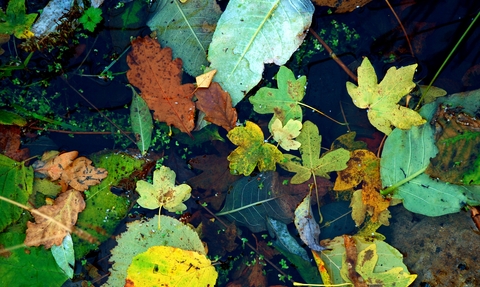
© Zsuzsanna Bird
Become a Leaf Detective and Help a Hedgehog!
Sensational autumn sights
A walk with friends or family can be a real treat at this time of year and there’s lots to look out for from the leaves changing colour on the trees, to the conkers and acorns which can be found on the ground, plus there are lots of different types of fungi, which you can spot on the ground, on trees and growing out of deadwood.
Do this:
- Whilst you are kicking leaves on the ground, take the Trusts’ Autumn Tree and Leaf Detective Spotter Sheet and see if you can work out what they are.
- Dazzle your friends by learning to identify eight common fungi species with the Trust’s Fungi Identification Spotter Guide.
Wonderful wetlands
Wetland habitats are extremely important for wildlife and for people too! Wetlands provide wildlife with a place to eat, drink, shelter, live and breed, plus they store water and can help prevent flooding and droughts too, helping the effects of climate change. Reedbeds filter polluted water and improve water quality. Plus, every year, our wetlands host winter visitors – birds which have come from colder climates. They come here because our weather is milder and more food is available.
Do this:
- Take a deep dive into the Trust’s Wildlife Explorer pages to discover more about various wildfowl species.
- Curious to see what you can see on a lake or reservoir? Take the Trusts’ Geese and Swan Detective Spotter Sheet on a walk with you and turn it into an adventure of discovery.
- Round-up your friends and family and head to your local river and see how many of these river-loving birds you can find in the Trust’s River Bird Spotter Sheet.
Caring for garden birds during winter
During the colder months of the year, garden birds can struggle to find the food and water they need to survive.
Do this:
- Help out the birds that visit your garden by finding out how and what to feed them here.
- Tick off your garden visitors with the Trust’s Garden Bird Detective Spotter Sheet.
Make this:
- Feeling festive? Give garden birds a special treat at this time of year with the Trust’s guide to making a wreath for birds.
Go wild with a winter walk
Wrap up warm and enjoy a winter walk – there’s still plenty to see in nature at this time of year. The lack of leaves on the trees give you an opportunity to study the differences in their bark, and frost makes everything look really cool – especially seedheads – look for them by the side of the road.
Do this:
- Seek out colour, even on a grey day, with the Trust’s Winter Nuts and Berries Spotter Sheet.
Uncover the secrets of Hedgehogs
Even though we often see Hedgehogs in books and in stories, the reality is that Hedgehogs in the wild are struggling because of habitat loss and there is less of the food that they eat around. This means there are less Hedgehogs too.
Hedgehogs like to eat all sorts of bugs and because they hoover up insects in vegetable beds and flower borders, gardener’s really like them. They will also eat amphibians such as frogs, birds’ eggs and other things they can catch, like worms and beetles. Hedgehogs are most active at night so if you are lucky enough to see one it will probably be when it’s dark!
Do this:
- Find out more facts about Hedgehogs here.
- Meet a giant Hedgehog! ‘Willoughby’ is a giant Hedgehog made from Willow, created by artist, Deb Hart and sits in the Trust’s wildlife garden in Verulamium Park, St Albans. The garden is open all year round so get your gang together and come and grab a selfie with a larger than life Hedgehog!
Help a Hedgehog
Did you know that over winter, Hedgehogs hibernate in a dry, warm space – often in a pile of leaves or logs called a hibernaculum?
Do this:
- Create a cosy space for a Hedgehog by building a Hedgehog home in your garden so it’s ready for them to move into in November.
- Picture this: The average Hedgehog likes to roam about 2km every night. Being able to move from garden to garden is really important for their survival but because many of us have fences it’s not always easy for them to do so. If you and your family can create a hole in your fence, or a channel beneath it, you’ll open up the start of a Hedgehog highway. If you can get your neighbours to do the same, you’ll be inviting them to roam throughout your neighbourhood – let’s call that a superhighway! Find simple details on how to create a Hedgehog hole here.
Visiting our nature reserves
We hope that through becoming a Wilder School, your students enjoy learning more about the creatures that live alongside us and that this is just the start of a lifelong appreciation of nature. To continue their wildlife journey, please extend a warm welcome to your school’s community to visit our nature reserves with family and friends – these are a mixture of fantastic habitats, and, depending on where and when visits take place, different experiences await. For example, at a wetland site in winter, a wide variety of duck species might be enjoying life on a lake or reservoir, or in one of our ancient woodland reserves in spring the many wildflowers can be quite spectacular… Discover more about our nature reserves and get visiting information at hertswildlifetrust.org.uk/nature-reserves
